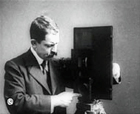  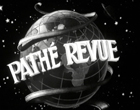 |
Reporters of the worldSince 1896, Pathé and Gaumont have devoted themselves to newsworthly events, providing both live broadcasts and reconstructions of events on a periodic basis. It was not until 1908 that Pathé Journal was founded, representing a new genre that was much admired and universally imitated. In 1910, Gaumont launched its own weekly news programme, Gaumont Actualités. Whenever an important story broke and a cameraman was close enough to witness the unfolding events, a film was produced. News companies, agencies and branches worldwide lent their assistance in capturing these images, which gave the newsmagazine an international, universal flavour. The news was broadcast after the main film at the close of the programme. The race was on, not just to gather information first but also to bring it to the silver screen. This spirit of competition gave each company the incentive to develop new techniques, particularly regarding colour processes. While Pathé opted for the stencil technique (images coloured individually), Léon Gaumont developed the Chronocrome process (a camera with three lenses that recorded images in blue, green and red simultaneously). When war broke out, Gaumont sent cameraman Pierre Perrin to the front, where he joined three colleagues, each of them working for a different news company: Alfred Machin for Pathé, Georges Maurice for Eclair and Pierre Emile for Eclipse. These men would later form the core of the photography and film division of France's armed forces. The weekly news programme was taken off the air during wartime. When it reappeared in 1919, Gaumont produced a bimonthly humor programme, Le Canard en Ciné, which was broadcast along with the newsreel. Pathé also introduced new programmes as part of a different genre: the Pathé Revue . |
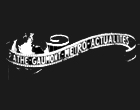 |
The rooster and the daisyIn 1927, Gaumont and Pathé joined forces for the first time and commissioned Loew Metro Goldwyn to produce a joint programme, Pathé-Gaumont-Metro-Actualités. Following a breach of the agreement between Société des Etablissements Gaumont and Metro Goldwyn Mayer, this programme continued under the name Pathé-Gaumont-Actualités until August 1931. From 1932 to 1935, in addition to the main newsreel, Pathé Natan broadcast an original weekly newsmagazine: Actualités Féminines |
France-actualités-gaumontLooking to diversify its activities, the industrial group Empain entered the film industry in April 1932 by founding France-Actualités, a French company devoted to news "talkies" and documentary films. This venture, produced in association with Gaumont-Franco Film-Aubert (GFFA) and called France-Actualités-Gaumont, first appeared in October 1932. |
|
Gaumont and agence havasGFFA became a major stakeholder inFrance-Actualités thanks to Agence Havas, and in return sold the latter news agency a large share of the programme. This partnership gave the newsreel the same facilities enjoyed by Havas correspondents throughout the world and the support of a distribution network in French-speaking countries. On 9 March 1936, Agence Havas was appointed by GFFA to manage, arrange and produce the news programme, which became Havas-France-Actualités-Gaumont , with GFFA handling the distribution for nine years. In May of that same year, the production of the newsreel was entrusted to a new company created by the Agence Havas, Les Diffusions Modernes, to which France-Actualités contributed all of its assets in July 1939, including the entire series of newsreels produced since 1932 as well as other collections. |
|
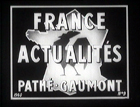 |
Wartime programmesDuring the occupation, when the Germans set their sights on producing a programme for occupied France, they demanded that Havas relinquish France-Actualités and Havas had no choice but to comply. Under government pressure, Gaumont and Pathé each took up a 30% share of the programme, thus acquiring France's entire interest in the newsreel. France Actualités screenings were often the scenes of violent outbursts, and cinema managers were forced to keep theatres lit during screenings to avert public demonstrations. The introduction of a single programme policy in occupied France pushed Société Nouvelle des Etablissements Gaumont (SNE Gaumont) to produce, with Pathé's assistance, a programme for unoccupied France. From 1940 to 1942, Pathé and Gaumont would produce newsreels for broadcast in the south of France under the name Pathé Journal de Marseille (or the Journal de Vichy ). From 1942 until 1944, however, one programme held a monopoly and was broadcast throughout France: France Actualités , produced by a Franco-German company founded after negotiations between occupying forces and the Vichy government. From the autumn of 1943, this programme was almost completely under the occupier's control. The Pathé and Gaumont newsreels both came back to the screens in 1946. |
The censor keeps watchWhile censorship of information eased under the Fourth Republic, it clenched its fist again during the Algerian war. Every Wednesday, the news was presented to a committee that included the Minister of Information. Gaumont's Jean Jay illustrates the impact of fimed information at a time when television was steadily establishing itself: "Our correspondent sent us images of Georges Bidault - the Prime Minister and supporter of French rule in Algeria - fleeing the country. When I learned that my correspondent also worked in television, I called some colleagues who had broadcast the programme the previous evening before I screened the film. Wednesday came and the principal private secretary informed me that the Minister wished to see me; he advised me to cut the story. When I told him that it had been shown on TV the evening before, he replied: 'I don't care about TV - people are at home, they're not demonstrating, if they don't like it they can turn it off; but in the cinema... can you imagine? Some people will applaud, others will whistle...'" |
|
 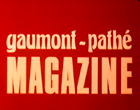 |
The TV yearsTV made its debut in 1949 and rapidly expanded. Both Pathé and Gaumont felt it necessary to redefine their editorial policy in the 1950s. Faced with the poor-contrast black and white images broadcasted by RTF, the two companies introduced colour news programmes in 1955. To supplement the purely factual field of current affairs, Pathé and Gaumont branched out into documentary films that covered a wide array of carefully selected topics (for example, major stories on visits to foreign countries, profiles of artists, and even reports on societal issues). As the number of television viewers grew, newsreels fell more and more out of favour.Eclair Journal stepped down in 1969, the year in which Gaumont acquired a major share of the Eclair company. In April 1975, Gaumont and Pathé collaborated for their last joint venture, Gaumont Pathé Magazine, but the project stalled after only a few months. Both Pathé and Gaumont withdrew entirely from newsreel in the mid-1970s, and the cameramen shelved their equipment once and for all in 1981. |
FILM LIBRARIESNewsreels, documentaries, collections of images covering widely varied subjects assembled over the years by editors, stories left on the cutting-room floor, and countless outtakes - in total, thousands of hours of landmark images - have all been lovingly preserved. While Pathé and Gaumont share a similar history, they retain their individuality thanks to the differing editorial policies of the two companies. What's more, when it comes to expanding their collections, both Gaumont and Pathé have pursued acquisition policies (American collections, Arkeïon, Atlantic Films, amateur films, Roger Pic, Samouraï, Sygma and so on) and marketing rights (Alain Lartigue, Braunberger, Claude Caillet, Conus, Films A Cellier, JL Productions, Kanapa, Laurence Lemaire, Lodge Productions, Mahuzier, ONF, Orchidées, Periscoop, Tadié, Théopresse, TYM Video Production) that have provided GP archives with a collection that spans the period from 1896 to the present day. So, the archive is not only an invaluable record of the history of the 20th century, it is also devoted to covering the events of the 21st century as they unfold around us. |
|
|
|